No matter where you’re going, you need one of the best hitch cargo carriers for your car to haul the cargo. It’s not easy to pack everything you need in your car, especially if you’re going camping, traveling, or you’re a working professional who needs large tools and machines. If you’ve ever needed to bring just one more suitcase, your bicycle, or a lawnmower on a trip with you, you know the frustration of not having enough space in your trunk.
However, choosing the ideal model is not an easy task. Because of that, we prepared hitch cargo carriers reviews of our favorite models available on the market today. You can rest assured that our reviews are completely unbiased. Let’s jump straight into it!
See The Quick Comparison Chart
Benefits of Hitch Cargo Carriers
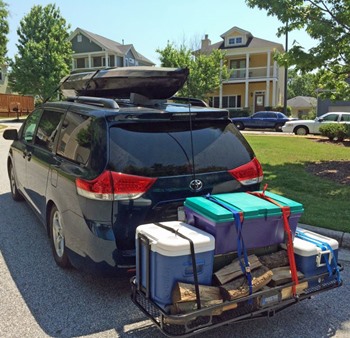 It’s not hard to imagine the situations in which a hitch cargo carrier could come in handy. In fact, there are several ways in which having one can make your life a bit easier. Let’s go through the most important ways in which you can benefit from investing in a hitch cargo carrier.
It’s not hard to imagine the situations in which a hitch cargo carrier could come in handy. In fact, there are several ways in which having one can make your life a bit easier. Let’s go through the most important ways in which you can benefit from investing in a hitch cargo carrier.
1. Free Up the Car Space
The most direct benefit of having a way to haul cargo outside of your car is quite intuitive – it frees up space inside. The fact that you have suitcases doesn’t need to make your travels uncomfortable and cramped. Simply load your suitcases onto the carrier, tie it up, and cover it if it’s going to rain. In this simple way, you ensured everybody in the car gets enough leg space, and that you won’t get cramped in your own car in the first few hours of driving.
The same thing applies to other situations as well. Whatever you need to bring with you, simply load it to the rear of your car, and there’s no need to worry about bringing everything you need. And most importantly – you keep the inside of your car for yourself, comfortable and cozy. No more stuff taking over your leg space.
2. Keep Dangerous Load Outside
Sometimes you just have to get stuff that you wouldn’t leave in your living room – well, you shouldn’t leave it in your car either. Cars are small, enclosed spaces, so keeping the air quality high and unpolluted is important. Having an outdoors cargo option is a lifesaver if you need to carry chemicals that are not doing your health any favors (especially if they evaporate), such as paints, glues, chlorine, gasoline, and pesticides. With cargo like this, we’d always recommend hauling the stuff outside, without ever getting it into your car at all. That way, you never have to fear that sitting on the inside of your car isn’t good for you.
3. Ease of Use
One of the best things about hitch cargo carriers is that they’re incredibly easy to use.
First of all, they’re quite easy to install. You won’t be needing more than 10 minutes to set one up. Furthermore, if you get the foldable one, you won’t need to worry about installing the carrier in your car ever again. With these, it’s enough to simply fold them up, and you can use your car like the carrier never existed, yet you can simply fold it down if you ever need additional hauling capacity.
On the other hand, hitch cargo carriers are easy to load. This is especially true if you need to carry large, heavy items like suitcases, barrels, or industrial machinery. If you ever tried to load some of these items onto a roof carrier, you will truly appreciate how simple and effortless using a hitch cargo carrier is. The best part is that getting the cargo off is as easy as getting it on, unlike roof carriers with which taking the cargo down takes advanced physical fitness. Taking your stuff off a hitch carrier can be even easier if you get a model that includes a ramp. In that case, you can simply slide your stuff on and off the carrier. Of course, a hitch cargo carrier is also quite a step up from storing cargo inside your trunk, which can often be small, cramped, and cluttered with items you can’t just take out and leave at home. A hitch cargo carrier makes both rooftop cargo carriers and trunks seem like too much work.
Types and Uses of Hitch Cargo Carriers
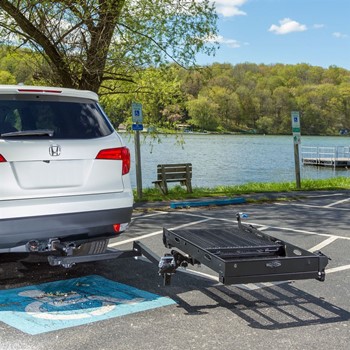 Hitch cargo carriers come in different shapes and sizes, so you can choose exactly the type that suits your needs best. The main differences between the types of carriers lie in the shapes of their two most important parts – the platform itself, and the shaft which holds it attached to your car.
Hitch cargo carriers come in different shapes and sizes, so you can choose exactly the type that suits your needs best. The main differences between the types of carriers lie in the shapes of their two most important parts – the platform itself, and the shaft which holds it attached to your car.
1. Platform Types
Platforms of hitch cargo carriers come in two major types: basket and flatbed. Which type you choose limits the shape of the cargo you will be able to carry.
1.1 Basket
Basket type carriers have the platform in the shape of a basket – a flat surface surrounded by rails. This is the most commonly chosen type of a platform because the rails prove very useful for tying cargo straps, ropes, and cords. Basket style platforms typically have either a mesh floor or a set of bars, while some also have a combination of the two. As you can imagine, both types have their advantages and disadvantages, especially when it comes to carrying small items.
1.2 Flatbed
Flatbed type platforms are somewhat different than the basket type. They don’t have rails, and instead, they look more like a flat platform with somewhat raised edges. On the edges, you can typically find several anchor points that you can use to tie down your cargo with straps and cords. Flatbed type platforms are commonly used for cargo which is oversized or in odd shapes. For example, large bicycles and motorcycles might be hard to fit onto a basket-type platform as their wheels often can’t fit within the railed platform. Like with the basket type of a platform, the most common type of a floor is mesh. Bar floors are quite rare.
2. Shaft Types
Shafts are used to connect the carrier to your car’s hitch. The entire construction relies on the strength of the shaft, so the design of this part is quite important. Another function the shaft may have is to raise the position of the cargo carrier because tow hitches can be placed quite low.
The most common types of shafts are straight, curved, and Z-style shafts.
2.1 Straight
This type of shaft is a very simple, straight bar that connects to your hitch. The straight type doesn’t raise your carrier, but it’s very sturdy and its design reduces bouncing and rattling of your cargo.
2.2 Curved
Curved shafts are popular because they raise the height of your cargo carrier. This is a good thing because it increases the ease of access you have to your stuff. However, if you intend to use your carrier for very heavy items that you can’t lift very high, you should consider getting one with a ramp. The downside of curved shafts is that they can be quite bouncy.
2.3 Z-style
This type of shaft is quite innovative, as it has the benefits of both other types of shafts, without their downsides. Z-style shafts are basically two straight bars bolted onto each other. This way, they do provide additional height to the positioning of the carrier. It also reduces bouncing and rattling as the bars used are straight. Finally, the most popular feature of Z-style shafts is that they’re foldable, making it possible to fold up and get the carrier out of the way when it’s not in use.
Best Hitch Cargo Carriers Comparison Chart
| PRODUCT | DETAILS | ||
|---|---|---|---|
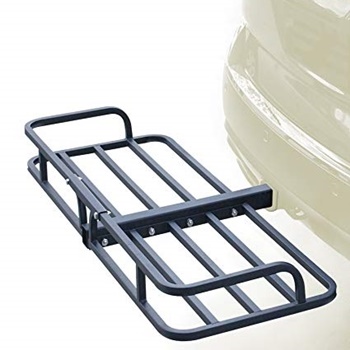 | CargoLoc 32500 Hitch Mounted Cargo Carrier |
| View On Amazon |
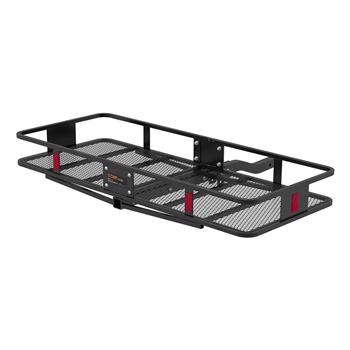 | CURT 18153 Basket Trailer Hitch Cargo Carrier |
| View On Amazon |
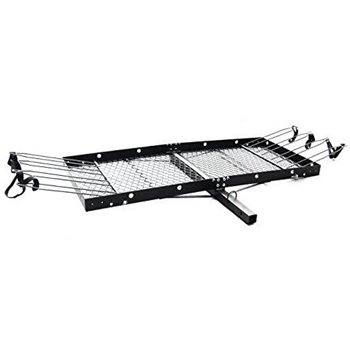 | Tow Tuff TTF-2762KR Steel Cargo Carrier with Bike Rack |
| View On Amazon |
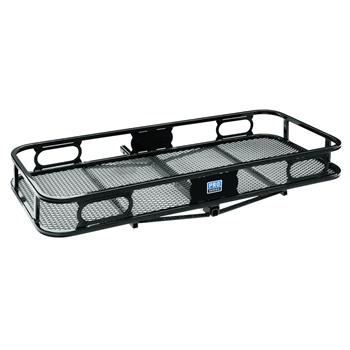 | Pro Series 63155 Rambler Hitch Cargo Carrier |
| View On Amazon |
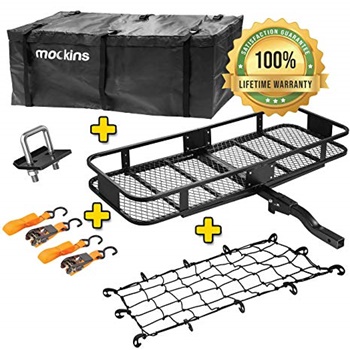 | Mockins Hitch Mount Cargo Carrier with Cargo Bag and Net |
| View On Amazon |
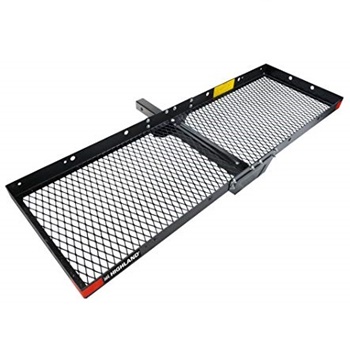 | Highland 1042000 Hitch Mounted Cargo Carrier – Black |
| View On Amazon |
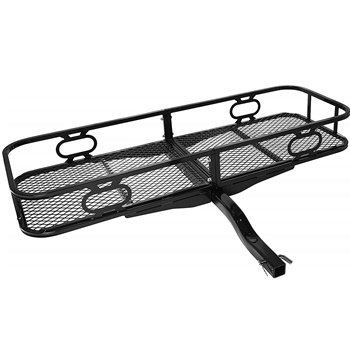 | AmazonBasics Hitch Cargo Carrier |
| View On Amazon |
Best Hitch Cargo Carrier Reviews
1. CargoLoc 32500 Hitch Mounted Cargo Carrier
 The next model on our list is made by CargoLoc, and it’s an affordable, unique hitch cargo carrier on our list. This model comes without a mesh flooring, and instead, the entire structure is constructed out of heavy-duty tubular steel. This makes the carrier very robust, and it ensures your cargo will arrive at your destination safe and sound.
The next model on our list is made by CargoLoc, and it’s an affordable, unique hitch cargo carrier on our list. This model comes without a mesh flooring, and instead, the entire structure is constructed out of heavy-duty tubular steel. This makes the carrier very robust, and it ensures your cargo will arrive at your destination safe and sound.
The material is covered with a carbide, powder-coat finish, which ensures your carrier stays rust-free. The platform is 48 inches wide and 19.5 inches long, which makes it the smallest model on our list. This is perfect if you have a smaller or narrower car.
The side rails are quite tall, at 4 inches. With this receiver hitch cargo carrier, you can freely haul up to 500 pounds of cargo, and this sturdy model will ensure you don’t have to worry about sagging. The straight shaft is not foldable, and it fits 2-inch hitch receivers. This hitch cargo carrier doesn’t come with pre-installed reflectors, so make sure to put some up before you hit the road. This way, you’ll ensure safety for you and the drivers behind you.
Pros
- This is the smallest model on our list, with the dimensions of 48 x 19.5 inches
- The tubular steel construction is very sturdy
Cons
- The shaft is non-foldable, but the smaller size means the carrier doesn’t get in the way
2. CURT 18153 Basket Trailer Hitch Cargo Carrier
 Curt’s basket hitch cargo carrier is one of the very good ones we’ve tried. With the hauling capacity of 500 pounds, this carrier can handle almost anything you throw onto it. Its curved shank is good because it lifts your cargo off the ground a little bit, making it more easily accessible.
Curt’s basket hitch cargo carrier is one of the very good ones we’ve tried. With the hauling capacity of 500 pounds, this carrier can handle almost anything you throw onto it. Its curved shank is good because it lifts your cargo off the ground a little bit, making it more easily accessible.
However, the main feature of the 2-inch shank is that it’s foldable. This means that you can fold the carrier up and move it out of the way when you’re not using it, without ever having to dismount it. The entire construction of this hitch cargo carrier is made out of tubular steel and coated with an E-coat and carbide black powder coat which protects the metal from corrosion and rusting. The bottom of the platform is made out of steel mesh, so it’s easy to maintain, and it can be used to tie down cargo for extra safety.
The dimensions of this carrier are 60 inches in width and 23.5 in length, making it quite spacious. It also comes with rather tall rails, which measure at 6 inches. They will keep your cargo safe, but also improve your driving safety. That’s because they come with reflectors that ensure drivers behind you will be aware of your cargo carrier.
Pros
- Comes with a foldable shank, so you can get it out of the way without dismounting
- It fits both the 1-1/4 and the 2-inch hitches
Cons
- Weighing 70 pounds, the steel construction is quite heavy, so you may require help installing it
3. Tow Tuff TTF-2762KR Steel Cargo Carrier with Bike Rack
 Our next pick comes from Tow Tuff, and it’s a unique product we reviewed because it comes with a bike rack. The rack can hold up to 4 bicycles, neatly stored one next to another in a standing position. The rack is equipped with adjustable wheel holders and tie-down holes which can hold your bikes in place, preventing any damage that may occur in transport.
Our next pick comes from Tow Tuff, and it’s a unique product we reviewed because it comes with a bike rack. The rack can hold up to 4 bicycles, neatly stored one next to another in a standing position. The rack is equipped with adjustable wheel holders and tie-down holes which can hold your bikes in place, preventing any damage that may occur in transport.
But even if you don’t need to haul bicycles, this carrier is a great choice for any cargo type because the rack pins can be removed. The total carrying capacity is rated at 500 pounds, making it quite strong. Naturally so, as it’s made out of heavy-duty steel.
The choice of material also makes it quite heavy at around 60 pounds, so you may need a bit of help during the installation. In fact, the weight of this carrier is justified, as it’s the largest model on our list, at 62 inches wide and 27 inches long. This flatbed carrier doesn’t have rails, but it has 3 inches of the raised edge. Don’t worry, because the mesh floor provides ample space for tying down your cargo. The straight shaft is non-foldable, and it fits 2-inch hitches.
Pros
- This is the largest hitch cargo carrier we reviewed, at 62 inches wide and 27 inches long
- This carrier comes with a bike rack which can hold up to 4 bicycles
Cons
- The shaft can’t be folded up when you don’t need the carrier
4. Pro Series 63155 Rambler Hitch Cargo Carrier
 Pro Series make the next model on our list, and it’s a mini hitch cargo carrier that is made for any vehicle with a 1-1/4-inch hitch receiver. The dimensions of this carrier are ideal for smaller vehicles, as it’s 48 inches wide and 20 inches long. These dimensions make it one of the smallest models on our list. Its size also influences its hauling capacity, which tops at 300 pounds.
Pro Series make the next model on our list, and it’s a mini hitch cargo carrier that is made for any vehicle with a 1-1/4-inch hitch receiver. The dimensions of this carrier are ideal for smaller vehicles, as it’s 48 inches wide and 20 inches long. These dimensions make it one of the smallest models on our list. Its size also influences its hauling capacity, which tops at 300 pounds.
However, it still comes with high-quality, tall rails that measure 5.5 inches, which will protect your cargo wherever you go. The 1-1/4-inch, the non-foldable shank is curved, so it provides a bit more ground clearance. The construction is made out of tubular steel which has a powder coat finish to protect it from corrosion.
The mesh floor is also made of steel, and its design ensures easy maintenance and ample space for attaching your straps and cords. This model doesn’t come with installed reflectors, so make sure to get a pair before you hit the road.
Pros
- Fits 1-1/4-inch hitch receivers which are commonly found on smaller cars
- With the dimensions of 48 x 20 inches, it’s great for smaller vehicles
Cons
- It can haul 300 pounds, which is less than other models on our list
5. Mockins Hitch Mount Cargo Carrier with Cargo Bag and Net
 Our next pick is a Mockins set – a hitch cargo carrier that comes with all of the accessories you will need for simple, safe, and effective cargo hauling. This cargo carrier is a good choice for anybody who hopes to get a foldable model. The curved shank, which fits 2-inch hitch receivers, lets you fold the entire carrier, letting you get it out of the way without having to dismount it.
Our next pick is a Mockins set – a hitch cargo carrier that comes with all of the accessories you will need for simple, safe, and effective cargo hauling. This cargo carrier is a good choice for anybody who hopes to get a foldable model. The curved shank, which fits 2-inch hitch receivers, lets you fold the entire carrier, letting you get it out of the way without having to dismount it.
The platform of this folding hitch cargo carrier is made out of mesh supported with racks, and it measures 60 inches wide and 20 inches long. The entire structure is made out of steel, which is painted black and powder coated. However, many users find the coating quality poor, so the carrier may rust quickly. We recommend adding a layer of a spray that prevents rusting such as an enamel spray.
Apart from the cargo carrier, you get a large cargo bag, a cargo net, two ratchet straps, and a hitch stabilizer which prevents rattling.
Pros
- Comes with many accessories and necessities for cargo hauling
- The curved shank can be folded up, to move the carrier out of the way when not in use
Cons
- The paint and its coating are of a somewhat poor quality
6. Highland 1042000 Hitch Mounted Cargo Carrier – Black
 Our next model is made by Highland, and it’s the most affordable model among our reviews. This budget-friendly hitch cargo carrier is a flatbed type, so instead of rails, it comes with 2.5-inch raised edges.
Our next model is made by Highland, and it’s the most affordable model among our reviews. This budget-friendly hitch cargo carrier is a flatbed type, so instead of rails, it comes with 2.5-inch raised edges.
You can find plenty of handy tie-down holes on the edges of the platform, so it’s easy to use ratchet straps, bungee cords, or even a cargo net. The mesh platform itself is a large one – it measures 60 inches wide and 20 inches long. The entire construction is made out of powder-coated steel, so it’s rather strong. It’s rated for 500 pounds of hauling capacity, but we found the platform a bit flimsy. It rattles a bit when driving on less-than-perfect roads, so we highly recommend securing the connection with the hitch receiver with a hitch stabilizer.
The shaft is straight, non-foldable, and it fits all 2-inch hitch receivers. The model comes equipped with reflectors, so other drivers will be aware of your vehicle’s additional length.
Pros
- This is the most affordable model on our list
- Solid flatbed type platform that’s quite large – 60 x 20 inches
Cons
- The carrier is a bit flimsy, so it may rattle. We recommend installing a hitch stabilizer
7. AmazonBasics Hitch Cargo Carrier
 AmazonBasics make our next model, and it’s a solid hitch cargo carrier that can help you enjoy any travel, tailgating, or road trip with more leg space in your car. The construction is made out of tubular steel, and it measures 60 inches wide and 21 inches long. The rails are quite tall as well, in fact, the tallest on our list, measuring 7 inches. These dimensions will ensure you travel stress-free, as your cargo will stay secure.
AmazonBasics make our next model, and it’s a solid hitch cargo carrier that can help you enjoy any travel, tailgating, or road trip with more leg space in your car. The construction is made out of tubular steel, and it measures 60 inches wide and 21 inches long. The rails are quite tall as well, in fact, the tallest on our list, measuring 7 inches. These dimensions will ensure you travel stress-free, as your cargo will stay secure.
The rails also come with provided cutouts for tail lights, which you can install if your cargo covers the tail lights on your vehicle. The reflectors aren’t pre-installed, though, so make sure you add them before your first ride. The basket type platform comes with a strong mesh floor reinforced by tubular steel rails. This makes the carrier quite robust, so it can handle up to 500 pounds of cargo.
The shaft is curved, adding a bit to the height of the carrier, and it fits any 2-inch hitch receiver. However, it’s not foldable, but you’ll be able to easily access your trunk as the shaft is quite long, so the carrier is a bit away from the vehicle. It doesn’t rattle easily, even though the shaft is long.
Pros
- The platform floor is rail-reinforced mesh, making it quite robust
- It has the tallest side rails on our list, measuring 7 inches
Cons
- The shaft is non-foldable
What Is a Hitch Cargo Carrier?
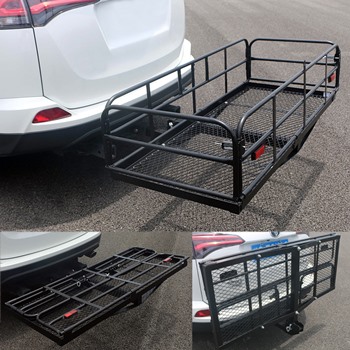 Have you ever tried to go on a camping trip, and just couldn’t bring everything you need with you? Or perhaps you’ve helped a friend move houses, only to realize the oven simply won’t fit inside your trunk. Some professionals need to haul large pieces of equipment that their work requires them to have, and the bulky stuff can take the entire backseat and the trunk.
Have you ever tried to go on a camping trip, and just couldn’t bring everything you need with you? Or perhaps you’ve helped a friend move houses, only to realize the oven simply won’t fit inside your trunk. Some professionals need to haul large pieces of equipment that their work requires them to have, and the bulky stuff can take the entire backseat and the trunk.
Hitch cargo carriers are the simple answer to all of the complex situations above. These simple tools are designed to provide extra space for cargo to your car, truck, or SUV. Hitch cargo carriers are attached to the rear of your vehicle, so the load you’re hauling doesn’t get in your way.
When it comes to design, hitch cargo carriers are very simple. They’re nothing but baskets you can attach to the back of your car, that is made to handle tough weather conditions, and to haul heavy loads. However, even though simple, hitch cargo carriers need to be robust and tough, so they’re made out of heavy-duty materials like steel and aluminum.
Every once in a while, everybody encounters one of those situations where you just wish you had some additional space for cargo. Whether that’s because you want to go camping, you’re traveling, organizing a tailgate party, getting gardening supplies, or you simply need to transport a piece of machinery, having some extra space available can save your day. There’s no need to place the bags of dangerous chemicals next to your children in the back seat – simply attach it to the carrier outside of your vehicle. It truly makes all the difference sometimes.
Hitch Cargo Carrier vs Roof Cargo Carrier
There are many different ways in which you can transport cargo in your car. The simplest of them is, of course, carrying the cargo inside the vehicle. But that’s not always possible, or the best choice available. When it comes to cargo carriers, there are two popular options – rooftop and hitch.
Rooftop vs Hitch
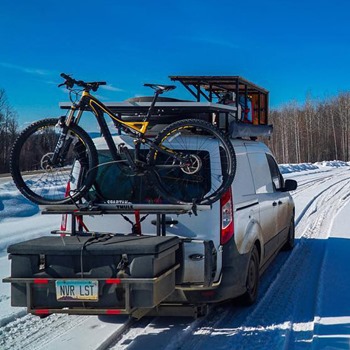 As the name suggests, a rooftop cargo carrier is fixed on the top of your car’s roof. Typically, it consists of two rails that can be used to mount a cargo box or to secure your cargo by tying it with rope or straps.
As the name suggests, a rooftop cargo carrier is fixed on the top of your car’s roof. Typically, it consists of two rails that can be used to mount a cargo box or to secure your cargo by tying it with rope or straps.
On the other hand, a hitch cargo carrier is a platform that is attached to the tow hitch at the rear side of your vehicle. Some hitch cargo carriers come in the form of a box, but the most popular kind simply consists of a platform that can handle any size of cargo. The rectangular platforms typically have a mesh floor and a set of safety rails around it. You only need to load your cargo onto a hitch carrier and secure it with straps or rope.
When a cargo carrier is mentioned, the first thing that most people think of are roof carriers which are somewhat more common than the hitch version. It’s hard to definitely decide which is the better option, as this ultimately depends on your particular needs and the model of your car. Still, though they both serve a similar purpose, there are big differences between the roof and hitch cargo carriers. Let’s take a look at the different aspects that you should consider.
1. Ease of Access
The first and foremost thing you should consider is how heavy or chunky your cargo is. When you use a rooftop cargo carrier, you must be able to lift your cargo overhead – which is usually easier said than done. Setting up your stuff onto a rooftop carrier can be quite physically demanding, and it often takes more than one person to do it. Even harder than lifting the cargo up is getting it down. one of the most common ways in which people damage their car windows or scratch their car paint is clumsy handling of cargo while loading or unloading the rooftop carriers.
Hitch cargo carriers are, on the flip side, rather easy to access. You only need to lift your cargo a foot or so to load the carrier. Some carriers even come with ramps which you can use to push or roll your cargo onto the carrier, without ever lifting a pound. This is a convenience feature that will make your life easier on many occasions.
2. Storage Space
It’s hard to determine exactly how much space each option offers. Both hitch and rooftop carriers can provide plenty of extra space for cargo. However, rooftop carriers can only hold as much as they can fit within the area of your roof. Additionally, the cargo needs to be tightly packed together for you to be able to haul it without worrying.
On the other hand, hitch cargo carriers give you a wide platform which is typically bigger than the roof area, and the cargo is shielded from the incoming airflow. A standard size hitch cargo carrier is around 48-60 inches wide, and 20-30 inches long. Apart from the platform size, the only restriction on the dimensions of the cargo you can load depends on how much of the rear window you’re allowed to cover.
3. Security
In general, there isn’t a big gap between the security of roof and hitch cargo carriers. Both of these can haul heavy cargo, and both require good straps to hold the stuff in place. Sometimes, hitch cargo carriers may seem wobbly, but that can be prevented with anti-rattle stabilizers and hitch tighteners. When it comes to security, there is one advantage of hitch cargo carriers compared to their rooftop counterparts. This is the fact that your cargo is shielded from the incoming airflow and wind by your car’s rear. When using a roof carrier, all of the airflow high-speed cause hit your stuff directly, without obstructions. Though it isn’t too common, it’s possible for the wind to damage or untie the straps that hold your cargo attached to the rooftop carrier, possibly resulting in a disaster. This is prevented when you haul your cargo behind your car, so it’s even safe to ride at high speeds.
Hitch Cargo Carrier Buying Guide
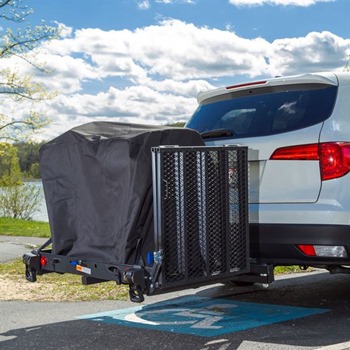 Which hitch cargo carrier you choose depends on your particular needs. Some people require higher hauling capacity, while others value the option to fold the carrier up when not in use. Even though these carriers aren’t complex machines, there’s still a lot to consider before you can bring the best decision. Finding an ideal hitch cargo carrier for your car is possible if you make an informed decision. Feel free to consult our hitch cargo carrier buying guide if you’re not sure which product is the right choice for you.
Which hitch cargo carrier you choose depends on your particular needs. Some people require higher hauling capacity, while others value the option to fold the carrier up when not in use. Even though these carriers aren’t complex machines, there’s still a lot to consider before you can bring the best decision. Finding an ideal hitch cargo carrier for your car is possible if you make an informed decision. Feel free to consult our hitch cargo carrier buying guide if you’re not sure which product is the right choice for you.
1. Capacity
Carriers come with different hauling capacities. In general, commercially available hitch cargo carriers can handle weights of 500 pounds at most. There are some carriers that can handle less, and for most people, around 300 pounds is as much as they ever end up hauling. It’s important to know how heavy the load you will carry is. If you’re a professional who needs to have heavy machines on hand, or you’re a motorcycling enthusiast who likes traveling on their bike on board, you should get a carrier with the maximum capacity of 500 pounds or more.
However, the carrying capacity of the hitch cargo carrier is not the only factor determining how much it’s safe to load. It’s important to check how much your car, and the hitch itself, can haul as well.
2. Materials
Hitch cargo carriers are most commonly made out of either steel or aluminum. Both of these materials have their own advantages and disadvantages.
Steel is more popular than aluminum, but it’s heavier. Because of that, the heavy steel carriers can be quite challenging to install. If you plan on removing and reattaching the carrier, we recommend you to go with the lighter aluminum. On the other hand, steel is tougher and more resistant to bending, deforming, and scratching than aluminum is. Because of that, aluminum hitch cargo carriers usually have a lower hauling capacity.
However, steel rusts faster than aluminum does. All steel carriers should be thoroughly covered with a powder coat finish, which prevents rusting. We’d advise avoiding steel models that don’t have a powder coating.
3. Base Dimensions
One of the main features you should pay attention to when buying a hitch cargo carrier is the dimensions of its platform. Of course, the bigger the base, the more cargo you’ll be able to carry on the back of your car. In general, manufacturers typically make platforms that are 48-60 inches wide and 20-30 inches long. When determining which dimensions to get, you should also measure the width of your car’s rear side.
4. Hitch Size
Every hitch cargo carrier is attached to your car via the tow hitch at the bottom of your car’s rear side. Cars come with two sizes of hitches – 1-1/4-inch ones, and 2-inch hitches. Larger vehicles, such as Jeeps, SUVs, and vans typically come with a 2-inch hitch. Your carrier needs to have a shaft that connects to the properly sized hitch. When choosing a carrier, make sure you pick the correct hitch size. If you can’t find the correct size, you may get an adapter, although the adapter may lower the hauling capacity of your carrier.
5. Foldable Shaft
Some hitch cargo carrier shafts can be folded so that the carrier doesn’t take up space on the rear of your car. This can be quite useful, as it gets the big platform out of the way when it’s not in use. It’s also much more convenient and simpler than dismounting the carrier and installing it back once you need it again. On the other hand, hitch cargo carriers are quite easy to install, so using a non-foldable model suits most people just fine. From our experience, most people don’t dismount their carriers at all, and just leave them on their vehicles whether they’re using it at the moment or not. However, if your garage is smaller than the length of your car plus the carrier, you may want to opt for a foldable design.
6. Ramp Access
Depending on your needs, you may want to consider a hitch cargo carrier with ramp. This feature allows you to simply slide your cargo onto the carrier, instead of lifting it up. If you plan on transporting cumbersome cargo, such as a motorcycle, you may want to consider getting a model with this feature.
7. Rail Height
We already mentioned that there are two kinds of hitch cargo carrier platform types – a flatbed type which is flat and without a railing system, and a basket-type which is surrounded by rails. These rails protect your cargo, and they’re very handy for tying down your stuff with cords and ropes. However, they limit the size of your carrier, so you may not be able to haul large, odd-shaped objects such as a bicycle.
Still, rails keep your cargo in place. They’re there to keep your things from shifting, sliding, and possibly falling off of your moving vehicle. As you can imagine, the taller the rails, the safer you are.
No matter the size of your rails, you should always secure your cargo with strong cords.
How to Install a Hitch Cargo Carrier?
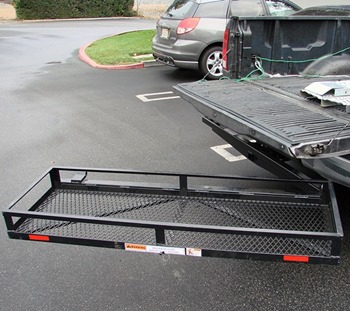 Installing a cargo carrier is very easy. However, most carriers are made out of steel or aluminum, which means they’re quite heavy. Because of that, you may require the help of another person to lift and install the carrier in place.
Installing a cargo carrier is very easy. However, most carriers are made out of steel or aluminum, which means they’re quite heavy. Because of that, you may require the help of another person to lift and install the carrier in place.
1. The Hitch
Hitch cargo carriers are installed into the towing hitch. Most cars, trucks, and SUVs already have one of these. If your vehicle doesn’t come with a hitch, you can get an interchangeable hitch and have it installed.
Hitches come in two standard sizes – 1-1/4 inches, and 2 inches. Most large vehicles like SUVs and trucks come with a 2-inch hitch, so that’s the default size that most cargo carrier manufacturers use. You should determine the size of your hitch before purchasing a hitch cargo carrier. If you’ve made a mistake, you don’t have to worry, though. You can get an adapter that changes the size of your hitch. However, you may experience a bit more rattling with an adapter than you would otherwise.
2. Carrier Assembly
Some hitch cargo carriers come as one piece, but most of them require assembling. Luckily, they usually only come in a couple of large parts, so the assembly is quite simple. Most carriers are only separated into two sides of the platform, and the shaft which connects them.
You will need a wrench to secure the construction with a couple of nuts and bolts. Most likely, you will get the fitting bolts and nuts in the box with your carrier. Follow the user manual you got with your model for specific assembly directions.
While assembling, we recommend securing your bolts with their heads on the inside, with the nuts outside. Don’t leave any sharp edges which could damage and tear your cargo or cargo bags. If you can’t screw the bolts into the nuts, add some silicone over them to make the edge softer.
3. Installation
Once you’ve assembled the carrier, you can proceed to install it into the hitch of your car. Align the shaft to the hitch. You may need the help of another person to do this, as you will have to lift the carrier to reach the hitch.
If you have the correct hitch size, it should be as easy as sliding the carrier’s shaft into the hitch. If it doesn’t go in smoothly, wiggle a bit to get it in. Once it’s completely inserted into the hitch, you should be able to run the hitch pin through and lock it.
Once you do this, your carrier is installed. Take it for a test run. If you hear or feel rattling, we recommend tightening the hitch pin or installing a hitch tightener.
If you need more information during the installation of your carrier, make sure to check your user manual or the manufacturer’s website for more information.
An Additional Note
Before you hit the road, make sure your carrier has reflectors installed. It’s important for other drivers to clearly see, even at night, that you have a hitch carrier installed. This is an important precaution so they don’t accidentally bump you, thinking there’s still space between.
If your carrier and cargo cover your license plate, you may have to get another one installed onto the carrier before you can legally drive with the carrier mounted. The same goes for your tail lights – if they’re not visible with your cargo on, you should have them installed onto the carrier as well. This is not an expensive modification, so don’t worry!
Hitch Cargo Carrier Accessories
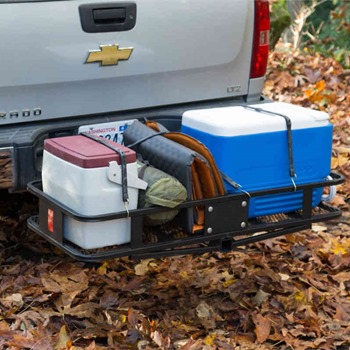 With a hitch cargo carrier, you will need to have a couple more accessories. These things will provide additional safety, and ensure that your cargo, you, and the drivers behind you stay safe and accident-free.
With a hitch cargo carrier, you will need to have a couple more accessories. These things will provide additional safety, and ensure that your cargo, you, and the drivers behind you stay safe and accident-free.
1. Hitch Security
There are two kinds of accessories that ensure your carrier’s shaft and the car’s hitch are connected as tightly as possible.
The first thing probably came in the box with your carrier – a locking hitch pin. Once you insert the shaft into the hitch, you will notice that there’s a set of holes in both that you should align. Once the holes are aligned, you should run this pin through the holes, locking the two bars in place.
If you hear some rattling during your test run, or the carrier generally feels wobbly, you can get an additional piece of equipment. A hitch tightener, also known as a hitch stabilizer, is designed to tighten the hitch and the carrier, keeping it in place. The U-letter shaped piece of gear tightens and supports the connection between your car and the cargo carrier, reducing rattling and shaking.
2. Packaging of Cargo
Before you can get onto the road with your cargo, you need to protect it. This is done with either a cargo bag or a cargo net.
A cargo bag is designed to keep your load tightly packed inside, protected from the elements and unable to separate and have parts fall off. The downside of cargo bags is that they come in limited sizes, so you must work out a way to package everything you’re carrying inside of one.
On the other hand, a cargo net will keep your things together, tied down to the carrier. However, the net will not keep your cargo protected in the case of rain, snow, or direct sunlight.
3. Tying Cargo Down
After your cargo is neatly arranged onto the carrier, and protected with a bag or a net, you need to keep it inside the carrier by tying it down. For this, you can either use ratchet straps or bungee cords.
Both of these are a good choice. However, ratchet straps most often have a mechanism with which you can tighten or loosen them, making them more versatile for different sizes of cargo. Because they have adjustable length, it’s possible for them to loosen a bit along the way, so you should invest in high-quality straps, and always check if they’re in place before you get going.
On the other hand, with bungee cords, there’s no risk of unplanned loosening, because they don’t have an adjustable length.
FAQ About Hitch Cargo Carriers
1. How do I know if I can mount a hitch cargo carrier to my vehicle?
To find out if you can mount a carrier to your car, you need to check whether your vehicle has a tow hitch cargo carrier installed. A tow hitch is located on your vehicle’s rear side, typically under the license plate. It’s a square-shaped receiver, with dimensions of either 1-1/4 or 2 inches. If your vehicle doesn’t have a hitch receiver, you may ask at a garage to see if your car can have one installed.
2. Is it against the law to drive with a hitch cargo carrier?
No. On most public roads, it’s completely legal to drive with a hitch carrier mounted. However, you should not drive with cargo on if it gets in the way of the visibility of your license plate and tail lights. If it does, you should have both installed onto the hitch cargo carrier itself. Additionally, make sure your carrier has reflectors installed. While some models come with reflectors pre-installed, you may have to add them yourself. It’s essential to have reflectors installed because you don’t want other drivers bumping into you at night.
3. Are hitch cargo carriers safe to use?
If used properly, it’s perfectly safe and easy to transport extra cargo with a carrier. To ensure you’ve got everything set up right, follow these guidelines:
- Make sure your license plate, tail lights, and reflectors are visible with your cargo on. If they aren’t, you should have the carrier modified, and install additional reflectors, lights, and a license plate installed onto it.
- Check your hitch lock to make sure your hitch cargo carrier is installed properly and well-attached to your car’s hitch receiver. The connection should feel secure, and you should pull on it to make sure it doesn’t come out.
- When placing your cargo onto the carrier, try to distribute the weight evenly across the platform. This way, you will make sure your carrier doesn’t rattle or pull your car to one side.
- Tighten your cargo with ratchet straps or bungee cords. Attach these to the rails of your carrier platform. You can use the carrier rails, or the mesh floor to tie your cargo down at many spots.
Wrap Up
Are you preparing for a cross-country road trip, and want to bring your bicycle and many suitcases along? Or, you’re a working professional who needs to bring large machinery and tools everywhere you go? Perhaps, you just want to help out a friend – help them move homes or simply lend them your lawnmower. Whatever the case, chances are, you can’t pack everything you need inside of your car’s trunk. There’s one thing that can make any of these feats a piece of cake – the best hitch cargo carrier for your car.
We hope we helped you narrow down the list of potential models for you with our hitch cargo carrier reviews. We gave our best to deliver an informative buying guide and unbiased reviews, that can truly help you make the best choice. If you have any questions for us, feel free to leave a comment below!
See also: car buffer reviews
I like the cargo carrier that has bikes above on top but cannot find one for sale. Any ideas on mfg or where to purchase?